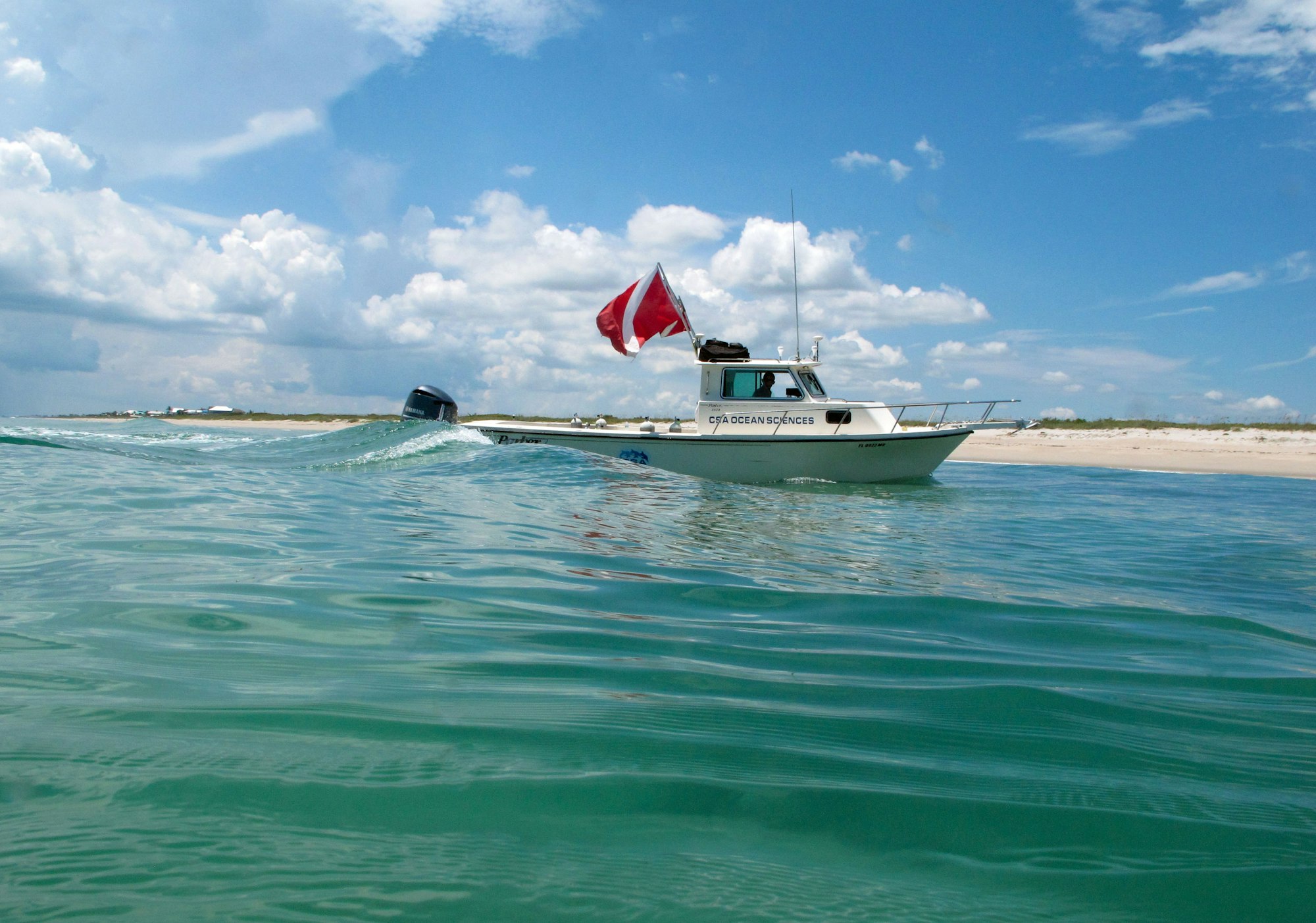Marine Biologists Complete Hardbottom Reef Survey at Sebastian Inlet

A team of marine biologists from CSA Ocean Sciences completed field work in late August as part of a hardbottom reef monitoring survey south of the Sebastian Inlet conducted by the Sebastian Inlet District in preparation for its planned beach renourishment project this Fall.
Hardbottom is exposed limestone bedrock in coastal waters within 400 meters from shore, in water depths up to approximately 4 meters or 13 feet. The Florida peninsula is rimmed with this exposed limestone, with a greater prevalence on the east coast. Hardbottom reefs dissipate wave energy and contribute to shoreline stability by acting as a natural breakwater. A naturally transitory system, hardbottom regularly experiences cycles of burial and exposure over time.
Nearshore hardbottom typically occurs as shore-parallel bands of exposed rock, and is critically important because it supports diverse biological communities that contain macroalgae, invertebrates, fishes and sea turtles. Over 1,000 species have been documented in these environments in Florida.
Juvenile green sea turtles can associate with shallow hardbottom for years as part of their development cycle, feeding on the macroalgae and using the structure for shelter. A report commissioned by the Florida Department of Environmental Protection (FDEP) noted endangered green sea turtles residing in bays and lagoons have shown higher occurrences of disease and injury and nearshore reef habitat may play a comparatively more significant role in the recovery of this endangered species. It also provides an essential fish habitat that includes spawning sites, settlement areas and nurseries for economically valuable and federally managed species such as snappers and groupers.
“July and August are ideal for hardbottom monitoring, with clear ocean water and great visibility,” said Martin Smithson, biologist and Administrator of the Sebastian Inlet District. “This type of biological monitoring is extremely important and we know from experience there is a way to carry out responsible beach re-nourishment projects with a focus on environmental protection. Both are part of our charter and we’re very proud that during the last 10 years of monitoring, there have been no negative impacts on these habitats.”
The team spent several weeks diving along and marking nine transects, or sections that run perpendicular to the shoreline, denoting each transect by using the FDEP R-monuments placed in the dune at 1,000-foot intervals (R-4 to R-17) and GPS. Scientists conducted quadrat surveys, measured sediment depth to analyze sediment movement along transects, measured algae height and hardbottom relief, and worked to map the western edge of the nearshore hardbottom for comparison purposes. They also collected photos and video of the flora and fauna in both the nearshore and offshore habitats.
Unique to nearshore hardbottom on the east coast is worm rock, a very important faunal component of this habitat. Worm rock is composed of colonies of the reef-building annelid tubeworm. The “rock” is soft and is made up of sand grains cemented together by a protein-like glue secreted by the worms. Often referred to as a habitat engineer, much like corals, the worms create these reef-like structures that provide food and shelter to a broad range of other species.
Florida has 825 miles of beaches that are vital to our state’s economy and environment. Sand lost due to longshore transport or erosion is replaced either from dredging offshore or from terrestrial sand mines. Beach renourishment projects pose a potential threat to nearshore hardbottom through primary and secondary impacts, burial or sedimentation respectively. Beach re-nourishment permits issued by the FDEP require biological monitoring of hardbottom. In 2016, to standardize monitoring protocols throughout the state, FDEP published their Standard Operation Procedures for Nearshore Hardbottom Monitoring. Five years of monitoring is required for comparison purposes to ensure nearshore hardbottom habitat protection and include; pre-beach renourishment, immediate post-beach renourishment, and three annual post-renourishment surveys thereafter.
The Sebastian Inlet District will be completing a beach renourishment project this Fall, after sea turtle nesting season ends on October 31. Bids are currently being accepted from experienced contractors to dredge the Sebastian Inlet’s Sand Trap and channel. 120,000 cubic yards of sand will be placed on the beaches south of the inlet from R-monuments 9 to 17. The District anticipates storing another 30,000 cubic yards of sand in the Dredged Material Management Area (DMMA) located in Sebastian Inlet State Park, on reserve for beach and dune repairs resulting from storms.
For a complete copy of the CSA Ocean Sciences report, once issued, or for more information, call (321) 724-5175.
The Sebastian Inlet District was created in 1919 as an independent special district by act of the Florida State Legislature, and chartered to maintain the navigational channel between the Atlantic Ocean and the Indian River. The Sebastian Inlet District’s responsibilities have grown to include beach re-nourishment and dune repair as part of a state mandated sand bypass system, erosion control, environmental protection and public safety. The Sebastian Inlet supports a rich and diverse ecological environment that is unparalleled in North America. The Inlet is vital not only to the ecological health of the Indian River Lagoon, but it is also an important economic engine for local communities in the region. Known as the premier surfing, fishing, boating and recreational area on the east coast of Florida, the inlet is one of only five navigable channels that connect the Indian River lagoon to the Atlantic Ocean.
